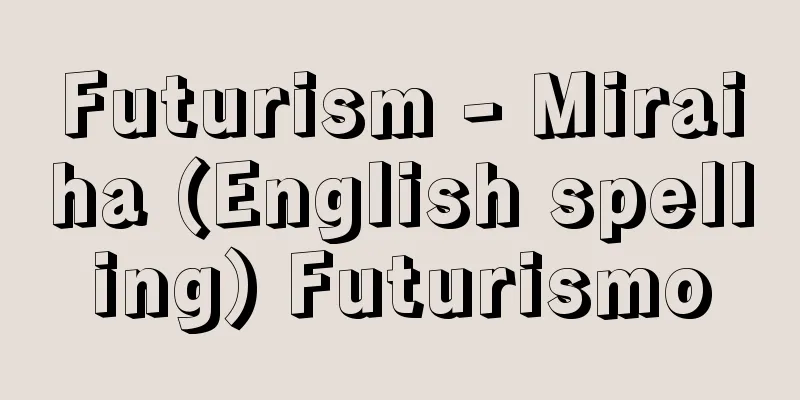Futurism - Miraiha (English spelling) Futurismo

|
Futurism is also known as Futurism. It was a revolutionary movement in literature and art that arose in Italy in the 1910s. It was sparked by the "Futurist Manifesto" by poet F. Marinetti, published in the Paris newspaper Le Figaro on February 20, 1909, and the "Futurist Literary and Technical Manifesto" published the following year, which advocated free language, and developed into a movement that encompassed various fields such as literature, art, theater, film, and architecture. They destroyed libraries and art museums, insisted on clearing the past, celebrated mechanical civilization, and advocated new forms suited to the new era, publishing a series of "technical manifestos" for each field. In literature, Marinetti, C. Govoni, G. Papini, A. Soffici, and A. Barazzeschi were at one time leaders of this movement, while in art, U. Boccioni, G. Severini, C. Carra, G. Balla, and L. Russolo were the five leading figures in the movement. In art, the Futurist movement focused on expressing speed and dynamism, and was noted for its attempt to incorporate the expression of movement into painting and sculpture. The Futurist movement was later linked to the glorification of war and was criticized for its support of Italian Fascism, but its significance is great in that it revolutionized Italian art. It also played an important role in paving the way for the European avant-garde arts that followed shortly thereafter, such as Cubism, Dada, and Surrealism. Source: Encyclopaedia Britannica Concise Encyclopedia About Encyclopaedia Britannica Concise Encyclopedia Information |
|
未来主義ともいう。 1910年代イタリアに起った文学と芸術の革新運動。 1909年2月 20日,パリの『フィガロ』紙に発表された詩人 F.マリネッティによる「未来派宣言」および自由語を提唱した翌年の「未来派文学技術宣言」が口火となり,文学,美術,演劇,映画,建築など各分野を包含する運動として展開した。図書館や美術館を破壊し,一切の過去の清算を主張するとともに,機械文明を謳歌し,新時代に合致した新しい形式を唱え,それぞれの分野についての「技術宣言」を相次いで発表した。文学ではマリネッティ,C.ゴボーニ,G.パピーニ,A.ソッフィチ,A.バラッツェスキらが一時期この運動をにない,美術では U.ボッチョーニ,G.セベリーニ,C.カルラ,G.バルラ,L.ルッソロの5人がこの運動を代表する。美術では速度とダイナミズムの表現を主眼とし,絵画,彫刻に運動の表現を盛込もうとしたことで注目される。未来派の運動はのちに戦争賛美と結びつき,イタリアのファシズムを支持する方向に向ったことで批判もあるが,イタリアの芸術を革新したことではその意義が大きい。また,すぐそのあとにくるキュビスム,ダダ,シュルレアリスムなど,ヨーロッパの前衛諸芸術を用意した点で重要な役割を果した。
出典 ブリタニカ国際大百科事典 小項目事典ブリタニカ国際大百科事典 小項目事典について 情報 |
<<: Mirasaka [town] - Mirasaka
>>: Taste bud - Mirai (English spelling)
Recommend
Viral infections - Virus infections
A general term for diseases caused by viruses that...
Brick chamber tomb - Senshitsubo
A tomb chamber constructed using bricks when the d...
Kalamazoo ruling - Kalamazoo ruling
...The spirit of this law was later embodied by H...
Celebration stick - Iwaibou
A sacred wooden stick used in celebrations of Litt...
Cardinal utility function - cardinal utility function
...The function u(・), which assigns a numerical v...
Eremurus; desert-candle
A general term for the genus Eremurus in the Lilia...
Weston Dynamo Electric Machine Co. (English)
…Because they also worked on arc furnaces, they c...
KU - Keyu
《 Organization of Kansai Unity 》⇒Kansai Regional O...
Gold Line Cider
…Originally it means apple wine (cider), but in J...
Lysimachos
[Born] Around 355 B.C. [Died] c. 281 BC. Ancient M...
Camera Obscura
…In his student days, he admired Byron and Scott ...
Burebista
...A region rich in gold and silver, it had been ...
Fuji's human hole - Fuji no Hitoana
Otogi-zoshi. Also called "Nita Shiro" an...
Rousset, J.
...The theories are diverse, and there is current...
roux brun (English spelling) rouxbrun
… There are two types of binders that thicken sau...









